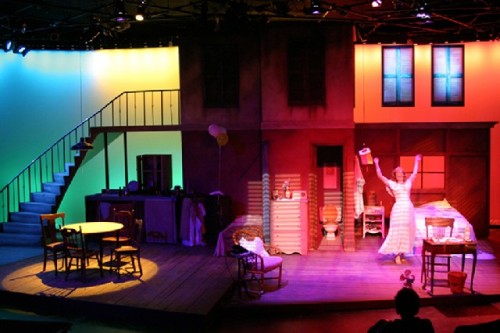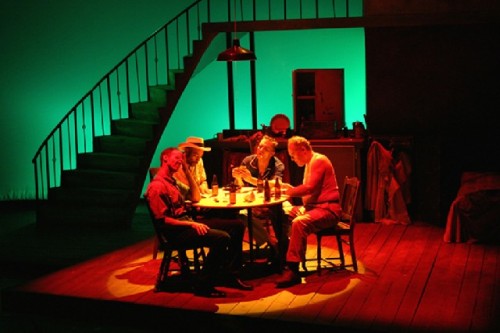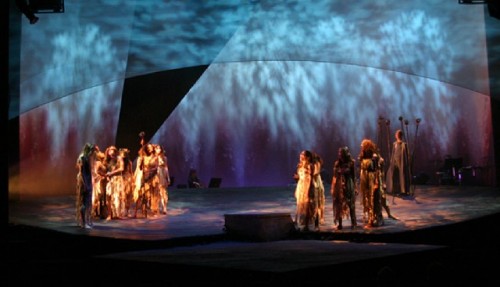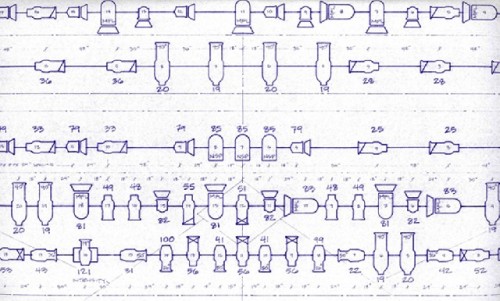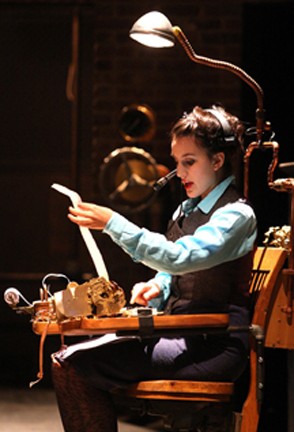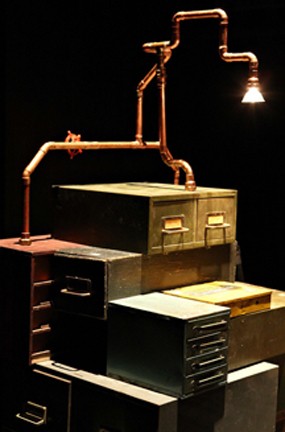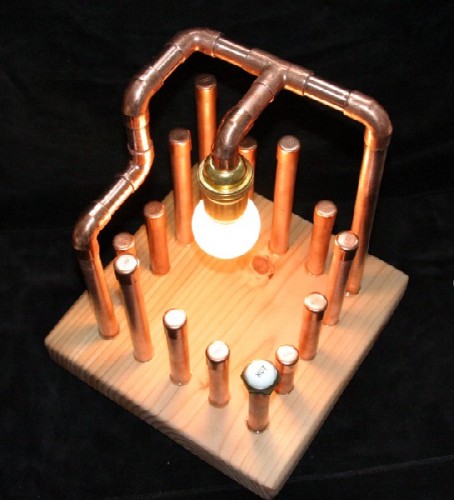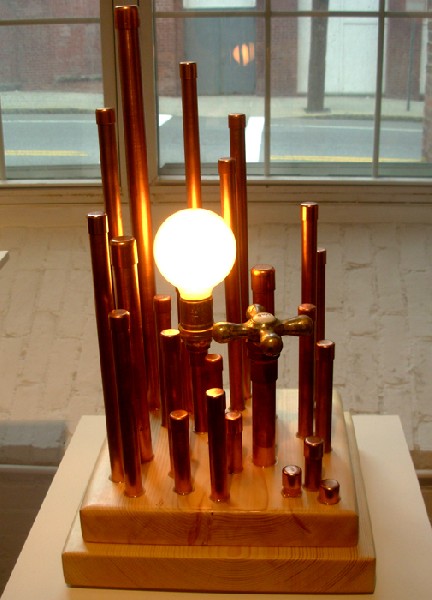Light Designer and Artist Julie Seitel's Practicals
Illuminati at The Eclipse Mill Gallery
By: Charles Giuliano - Jun 23, 2009
Once again it is proving to be an intense and busy summer for the North Adams based artist and light designer, Julie Seitel. She will spend a couple of weeks at Tanglewood working on a production of "Don Giovanni" conducted by James Levine. It is among the most anticipated events of the season. Last fall, while designing for a production of the avant-garde, feminist/ expressionist play "Machinal," by Sophie Treadwell, she worked with copper tubing and plumbing fixtures. This inspired Seitel to make unique lighting fixtures "Practicals" that evoke the aesthetics of constructivist sculpture with the functional aspect of illumination.
It was her first venture into making studio "art." One of the first pieces, which entailed a cluster of uneven sized, vertical copper tubes, mounted into a wooden box as a base, a globe light bulb, and an antique faucet handle, was include in an exhibition "The Eclipse Annual." She was excited to make her first sale, and full disclosure here, I bought the piece. During the recent "Berkshire Salon" which she organized for the Eclipse Mill where she resides, she made another sale. For more money I was pleased to hear confirming that my acquisition has already increased in value.
While taking the summer off from the 62 Center at Williams College she hopes to create a significant body of work. In addition to the thinking, planning and design of each unique piece it takes several days of fabrication. Right now she is exploring the potential of the work but is already thinking about creating an edition of multiples. When we met for a beer to discuss the work, and future plans, I suggested that Ikea is not unlikely down the line. It's exciting and challenging to think big.
The immediate agenda was to discuss plans for the exhibition she is curating for the Eclipse "Illuminati: Working in Light" which will be on view from July 31 through August 30. The Boston based artist, John Powell, will show a series of holograms. If some technical issues can be resolved he may install an exterior, site specific piece. He is known for transforming structures like Boston's City Hall and bridges over the Charles River into enormous light sculptures. In addition to Seitel's own works other Eclipse artists in the project include; Brian Jewett who makes lighting sculptures from recycled materials, and Marjorie Minkin who is adding light and sound, activated by sensors, to her molded lexan sculptures. The Williamstown based artist Richard Harrington will display one illuminated wall work. It relates back to work he created as a fellow at MIT's Center for Advanced Visual Studies.
While we have been neighbors and friends for some time it is always enjoyable to sit down over a pint and ask the kinds of questions that do not surface during social occasions. Basically, I wanted to know who are you, where do you come from, and what are you doing?
"I've been a recurring member of the theatrical design faculty at Williams College and at Stony Brook University, and I was the Production Manager & Technical Supervisor for the '62 Center for Theatre & Dance at Williams for 2007" she said. At some point she produced her business card that states her membership in Local 829 of United Scenic Artists. This means that she is a union member qualified to work on Broadway shows. In ten years in New York, before moving back to the Berkshires, she mostly worked in Off Broadway productions, with a staggering list of credits. For a long time she worked with the renowned light designer Kirk Brookman.
"That's how it works in my field" she explained. "Basically you apprentice to someone and they teach you the tricks of the trade. That gets you introduced to theatre people and from those contacts you start to establish yourself and take on your own projects and productions."
Backtracking we learned that Julie is a Leo (August 14) who grew up in Bozema, Montana. Not exactly a launching point for a life in the arts. She came from a family of physicists and engineers. In high school, it must have been in the genes, she became interested in the physical properties of light and music.
"I love Montana" she said. "It is such a beautiful place although winters can be bitterly cold. My father formed his own company and because of the nature of the work he could live just about anywhere and opted for Montana. My friends were very homogeneous and I came to feel that there had to be more out there."
Based on very impressive college entrance scores she started to receive brochures from recruiters and admissions offices. This narrowed when she decided to "Cross the Mississippi." She laughed when she related that the best brochure promoted Willams College. Lured by that well designed marketing she came east. She is a graduate of the Williams Class of 1994.
"If I had the guts I would have gone straight to New York" she stated frankly. "But I ended up at a potted ivy school. That's how we refer to small schools like Williams, with student bodies under 2,000, but aspiring to the standards of the Ivy League. I went with who had the coolest brochure. The Williams one was so smooth. Pathetic but true."
I commented that the Williams marketing department will be thrilled if they get to read that endorsement. But I wondered how a down to earth girl from Montana adapted to upscale, elitist Williams? She responded that yes there is that "legacy" element but the student body is remarkably diverse.
One feature of the Williams program is that students can design their own field as "Contract Majors." This entails getting faculty members from three departments to sign on as sponsors and advisors. "There is no department of Film Studies" she explained, "But film is taught in the English Department and in other departments. So it is possible to major in film." She was unsuccessful in the attempt to design a major in Aesthetics. While in this process, as a freshman, she took her first course in Theatre and the rest, as they say, is history.
She was immediately involved with the back stage aspects. Her interest in performing, apparently, ended in the third grade. As a Theatre major she was required to take an acting class which she describes as a nightmare. But she understands its importance and value. Williams students get to work on productions which are remarkably complex and professional. That set for "Machinal" which we attended and reviewed proved to be quite astonishing
Working as a lighting techie meant walking around with a crescent wrench in her back pocket. Because of the danger of its falling and hitting someone when working on a ladder it is protocol to attach it by a cord to a clamp on your belt. That wrench in the back pocket also serves as a signifier. On my note paper she drew a diagram of the wrench and its attaching system.
"I began to wear my wrench everywhere, in the dorm, at class, and even on dates" she said with some amusement. "It was an ice breaker at keggers. A guy would spot it and ask what is that? Why is it in your back pocket? You got to explain what it is and what you do."
For fun I tried to rag on her a bit as a "wrench girl" but she was emphatic that it was a phase and she evolved to light design. At Williams there was the kind of hands on mentoring that she now regularly provides to students who work under her on productions.
"Design is about having a point of view about a play" she said. It starts with studying a script and taking notes. If an actor says something like "It's a beautiful day" how do you light that? "At the root of all design is critical thinking about human nature and the characters in the play. It is an examination of the world that they live in. If you are working on 'Streetcar Named Desire', for example, Blanche arrives in New Orleans to live with her sister Stella. What is the city that she sees? How do you express that environment so the audience feels what she sees? You show on stage what she says and what it means."
Seitel discussed the collaborative nature of theatre. She sits in on meetings as a member of the design team. There are set and costume designers, sound, and light designers. The director presides as the captain of the ship making all of the final decisions. Everyone else is a part of the creative team.
She described how that process worked for the production of "Machinal" and its high tech design. Having been in that black box theater previously we were surprised when we entered from above with sight lines down onto the set. Even the seats and the elaborate copper rails were a design element. The play conveyed the tragedy of a woman surrounded by machines and apparatus that she did not understand. Ultimately the woman, who killed her husband, was executed by a machine in a macabre and chilling simulation of an electric chair.
"The world we fabricated that surrounded her was a gigantic, oppressive machine created from her point of view. She couldn't tell how it worked or what the rules were. She was at a complete disadvantage. There were all kinds of handles and valves but she didn't know if she turned them what would happen."
For that production Julie designed ten or eleven lighting fixtures or "practicals" as they are known in theatre. "Any scenic item that emits light is called a "practical." It can be as simple as a bare bulb."
Now that she is involved in making these lighting elements as works of art Seitel has decided to call them "Practicals." She says that "People who express interest find them to be practical. They are works of art with a useful purpose beyond just looking interesting and beautiful. In that sense they are Practical." It is an irresistible combination for collectors of unique sculptures as well as for those looking to accent a modern interior.
We anticipate with great interest the new pieces she hopes to finish in time for the opening of "Illuminati." Other than organizing the non juried "Berkshire Salon" this is her first curatorial project. She has been working with the artists for the past few months and planning how it will be installed. Given her skills in theatrical lighting it will surely be dramatic. Summer, it seems, is hardly a season to kick back and relax. At least not for artists.


